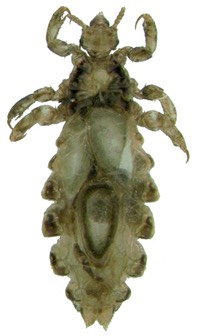Other insecticides are regionally available for use against head lice, but these should be avoided unless they are contained within formulated pediculicides that are approved by the FDA and are prescribed by a physician. Generally, prescription formulations containing these insecticides may be considered as second line pediculicides if live lice persist after two treatments with over-the-counter pediculicides, such as those containing pyrethrins or pyrethroids. The application of these prescription products, according to label directions, should not be expected to cause an adverse health effect to human beings. A second application is often needed, about 10 days after the initial treatment, though certain products may successfully eliminate lice after just one application. Note that whereas these products may kill lice (and in some cases the eggs as well), they will not remove those dead eggs from the hair. Dead eggs, as well as those empty nits that have already hatched, are not medically relevant and need not be removed except for aesthetic reasons.
FDA-approved prescription pediculicides include, as their active ingredients:
Spinosad is a mixture of biological insecticides derived from the fermentation of a soil bacterium, and is the active ingredient within the product Natroba that received FDA registration in January 2011. Spinosad is formulated in a topical suspension of water, alcohols and other ingredients and is labeled for a 10-minute application, then is to be rinsed off. Spinosad causes neuronal excitation in insects leading to their eventual paralysis and death.
Ivermectin is yet another mixture of biological insecticides derived as a fermentation product from a soil bacterium. It is the active ingredient within the product Sklice that is available (as of August 2012) as a prescription pediculicide. The topical formulation is labeled for a 10 minute application for patients 6 months of age and older. Ivermectin causes neuronal excitation in insects leading to their eventual paralysis and death.
Malathion is an organophosphate insecticide that has been used against agricultural, residential, landscape and public health pests for many decades. It is the active ingredient within the prescription pediculcide Ovide Lotion. The formulation contains 0.5% malathion in a solution of alcohol, terpineol, dipentene and pine needle oil. It is generally prescribed for an 8-12 hour treatment to the scalp hair, then rinsed off. Although resistance by head lice to malathion itself has been reported, this does not seem to extend to the formulated commercial product. Malathion is a cholinesterase inhibitor, leading to prolonged muscle contraction and eventual death in insects.
Benzyl Alcohol is the active ingredient within the prescription product Ulesfia. This formulation contains 5% benzyl alcohol. In combination with other ingredients within the lotion, it is said to kill lice by suffocation. It is labeled for a 10-minute application, then is to be rinsed off.
Lindane is an organochlorine insecticide that has been used for agricultural and medical purposes for many decades. A particular form of lindane at low concentration (1% USP) and with high purity is used for treating persons infested by head lice, pubic lice and scabies mites. It was formerly marketed in the U.S. under the brand name Kwell. Its use has been limited significantly because of its effects on quality of water in the waste stream, and it has been removed from the market in several countries. It is generally prescribed for a 4-minute application to the scalp hair, then rinsed off. Support for lindane as a pediculicide has waned in recent years because of concerns about risks from gross misuse and overuse, the existence of populations of head lice that have become resistant to this insecticide, and the availability of products perceived to carry less risk. More health-related information about lindane is available at www.ncbi.nlm.nih.gov/pubmedhealth/PMH0000736
Use caution when dealing with any insecticidal agent, particularly on children. Read, understand and follow label directions. Do not apply any insecticide or other chemical not specifically labeled for use on people. Well-intentioned parents treating their children with toxic or flammable substances have caused several deaths and poisonings. Because certain pediculicides contain flammable substances, they should not be used around source of ignition, such as open flames, spark-generating or heating devices. If you have questions about the use or safety of these products, ask your pharmacist or physician.

